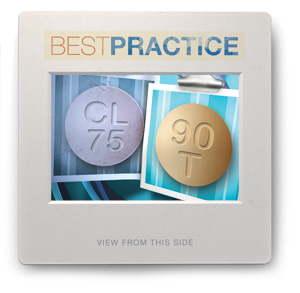2013 began with publication of the 50th issue of Best Practice Journal. In this edition we focused on the topic at the heart of primary health care in New Zealand: cardiovascular disease. It is a worrying statistic that cardiovascular disease is the leading cause of mortality in New Zealand, and that significant ethnic disparities exist in the prevalence of disease, access to treatments and overall health outcomes. Other important themes of BPJ in 2013 included promoting the safe use of medicines, profiling new treatment options and raising awareness of antimicrobial resistance. Before we move on to the articles of 2014, it is important to review what we have learnt so far.
In this article 
View / Download pdf version
of this article
The top five themes in Best Practice Journal in 2013 were:
Reducing the burden of cardiovascular disease and diabetes
Strategies for the management of patients with cardiovascular disease (CVD) and diabetes have featured frequently in
BPJ over the years. This reflects both the high prevalence of these conditions in New Zealand and the significant role
that primary care clinicians have in managing patients with CVD, diabetes and closely related conditions, such as chronic
kidney disease and gout.

Cardiovascular disease is the leading cause of mortality in New Zealand. However, disparities exist in both the prevalence
of disease and access to treatments. For example, the mortality rate from heart failure for Māori aged over 65 years in
New Zealand is approximately double that of non-Māori; the disparity may be even more pronounced in younger age groups
(45 – 65 years). Heart failure occurs approximately 10 – 15 years earlier in Māori compared to non-Māori.
The prevalence of type 2 diabetes is two to three times higher in Māori and Pacific peoples compared to European New
Zealanders. It is estimated that one-third of Māori and Pacific peoples aged 45 – 64 years have intermediate hyperglycaemia.
With the growing burden of CVD, diabetes, kidney disease and related morbidities in New Zealand, it is imperative that
patients at the greatest risk are detected early and receive the most intensive management.
Treating hypertension early to reduce CVD risk
An important article supporting this theme in 2013 was: “Hypertension in
adults: the silent killer”, BPJ 54 (Aug, 2013). There is currently a lack of consensus on the ideal management of
patients with hypertension, and international guidelines differ in their recommendations. What is agreed is that hypertension
is currently under-treated in New Zealand and blood pressure is an important modifiable risk factor for cardiovascular
disease.
A recent update to the New Zealand Primary Care Handbook recommends that all patients with significant individual cardiovascular
risk factors should have them managed. It specifies that pharmacological treatment be considered for all patients with
blood pressure ≥ 170/100 mmHg, irrespective of their calculated CVD risk. However, based on the United Kingdom’s NICE
guideline, the European ESH/ESC guidelines and local expert opinion, we recommended that all patients with systolic blood
pressure ≥ 160 mmHg should be treated, regardless of their calculated cardiovascular risk.
To diagnose hypertension, blood pressure is best assessed with two measurements, at least two minutes apart. Ideally,
measurements should be taken from both arms and repeated if the difference between arms is greater than 20 mmHg. Ambulatory
blood pressure testing is the gold standard for confirming a diagnosis of hypertension where availability and cost permit.
It should be considered if there are substantial differences between measurements taken in the clinic setting.
Initiating treatment for patients at risk is more important than which antihypertensive treatment regimen is chosen.
Hypertension is progressive and patients will usually require several changes in their medicine regimen over time to achieve
blood pressure targets and reduce overall cardiovascular risk. In general, patients can be started on an ACE inhibitor
or calcium channel blocker, and then these medicines can be combined, followed by the addition of a thiazide diuretic.
Beta-blockers may be added to the treatment regimen in patients with co-morbidities such as ischaemic heart disease or
atrial fibrillation.
A new management strategy for heart failure
A primary care clinician is likely to have approximately 20 patients with heart failure per 1000 patients – more if
the patient population is older. In the foundation articles: “Identifying
patients with heart failure in primary care” and “Managing
patients with heart failure in primary care”, BPJ 50 (Feb, 2013), a standard was outlined for caring for patients
with heart failure in the community.

The first article in the series outlined the changes in terminology used for describing and categorising heart failure.
This has been driven by evidence from clinical trials which have highlighted the significance of left ventricular ejection
fraction. Heart failure should now be differentiated as either heart failure with reduced ejection fraction (H-REF) or
with preserved ejection fraction (H-PEF). Making this distinction is important because, as the second article outlined,
the underlying cause and the treatment of each type of heart failure differ. The diagnosis and management of heart failure
therefore relies on the use of echocardiography, which should ideally be requested for every patient with suspected heart
failure.
Focusing on glycaemic control
Every day, approximately 50 people in New Zealand are newly diagnosed with diabetes. Most of these people will require
regular and intensive management to maintain their glycaemic levels below their individualised target. In the article:
“Improving glycaemic control in people with type 2 diabetes: expanding the primary
care toolbox”, BPJ 53 (Jun, 2013), the spectrum of diabetes treatments available for managing patients in primary
care in New Zealand was outlined. Achieving glycaemic control in patients with type 2 diabetes does not have to be limited
to prescribing metformin; add a sulphonylurea, initiate insulin, and if more established treatments are not tolerated
or not effective in achieving agreed HbA1c targets, consider whether other medicines such as pioglitazone or
acarbose may be appropriate. Lifestyle interventions such as a healthy eating plan, weight loss and increased physical
activity are also crucially important in all patients to help to reduce glycaemic levels.
Management of patients with type 2 diabetes is an ongoing and proactive process and patients with the poorest glycaemic
control require the most health care resources. Glycaemic control is not a “one size fits all” approach and a treatment
plan including appropriate clinical targets should be tailored to each patient, taking into consideration their age, co-morbidities
and motivation for treatment. Younger people benefit more from intensive control as they must live with the consequences
of diabetes for longer. Older people, who are more vulnerable to hypoglycaemia, may have less stringent HbA1c targets.
 See: “ Getting to know your patients with diabetes”,
for discussion on how to effectively engage with patients and understand their motivations and barriers to treatment.
See: “ Getting to know your patients with diabetes”,
for discussion on how to effectively engage with patients and understand their motivations and barriers to treatment.

Non-fasting lipids now acceptable for CVD risk assessment
The concept of no longer asking patients to fast for a lipid test was raised in a key article from Best Tests Journal
in 2013: “’Oh and while you are here...’ Fasting may be unnecessary for
lipid testing” , Best Tests (Nov, 2013). This article discussed the growing body of evidence and expert opinion suggesting
that, in the majority of patients, a fasting lipid test is not necessary for calculating cardiovascular risk or monitoring
lipid levels.
In December, 2013, the Ministry of Health released an update to the New Zealand Primary Care Handbook (the national
guideline for managing cardiovascular disease and type 2 diabetes). One of the new messages is that a non-fasting test
is an appropriate way of measuring lipid levels for the purposes of cardiovascular risk assessment.
The update also contains guidelines on the frequency of lipid monitoring:
- CVD risk > 20%: monitor non-fasting lipids every three to six months until stable, then every one to two years
- CVD risk < 20%: monitor non-fasting lipids at each CVD risk assessment. If lifestyle interventions are implemented
to reduce LDL-cholesterol, review non-fasting lipid levels after six to 12 months.
- The Handbook offers the following guidelines for initiating pharmacological treatment for lowering CVD risk:
- Healthy lifestyle interventions are appropriate for all patients
- Most patients with a five-year CVD risk < 10% can be managed without pharmacological treatment
- For patients with a five-year CVD risk between 10 – 20%, use a shared decision making approach to initiating lipid-lowering
and/or blood pressure lowering medicines
- Most patients with a five-year CVD risk > 20%, and all patients with a history of CVD, are likely to benefit from
lipid-lowering, blood pressure lowering and anti-platelet medicines
- All patients with significant individual risk factors should have them managed (irrespective of calculated CVD risk)
 The 2012 Primary Care Handbook, including 2013 updates can be found here:
www.health.govt.nz/publication/new-zealand-primary-care-handbook-2012
The 2012 Primary Care Handbook, including 2013 updates can be found here:
www.health.govt.nz/publication/new-zealand-primary-care-handbook-2012
Promoting the safe use of medicines
An underlying theme for all BPJ articles is to provide guidance on the safe use of medicines. A rule that can be applied
in most situations is: “Prescribe the lowest effective dose of medicine for the shortest possible time”. Patients treated
with any medicine long-term should have their regimen regularly reviewed, with the aim of lowering the dose or ceasing
the medicine if it is no longer required or if an alternative medicine would be more appropriate. Exceptions to this would
be when treatments need to be escalated to maintain control, such as in the ongoing management of patients with diabetes.
Patients should be given information about expected outcomes and potential adverse effects of their medicine(s), and advised
to report any symptoms. Laboratory monitoring may also be required.
The safe use of medicines also encompasses safely prescribing medicines and adopting strategies to avoid errors. These
strategies include being aware of any contraindications to the use of a medicine and checking for medicine allergies and
any previous adverse medicine reactions. When prescribing, use the generic name of the medicine (exceptions include warfarin),
avoid the use of abbreviations, include specific instructions for use and an indication for the medicine, check the prescription
before signing it and ensure that the patient/caregiver understands how to use the medicine and what it is for.
If a medicine is prescribed for a condition, at a dose range or via a route of administration which it is not indicated
for, it is referred to as “off-label” prescribing. An example of this is the use of quetiapine for anxiety, which is not
an approved indication. Some medicines may also be prescribed even though they are unapproved, which means that the medicine
has not been through the Medsafe regulatory process for approval in New Zealand. An example of an unapproved medicine
in New Zealand is benzbromarone. An “Upfront” article in BPJ in 2013 provided guidance on
the rules and recommendations for prescribing unapproved and “off -label” medicines in New Zealand:
“Unapproved
medicines and unapproved uses of medicines: Keeping prescribers and patients safe”, BPJ 51 (Mar, 2013).
Consider lower doses of isotretinoin
An important safe prescribing update was reported in the article: “Low dose isotretinoin
for acne?”, BPJ 56 (Nov, 2013). Isotretinoin is conventionally prescribed using a cumulative, weight-based dosing
regimen of approximately 150 mg/kg over several months. However, this involves patients taking relatively high daily
doses of 0.5 – 1 mg/kg, with an increased risk of adverse effects. Recent evidence suggests that isotretinoin prescribed
at a lower dose is as effective as higher doses for clearing acne and is less likely to result in adverse effects such
as liver abnormalities, photosensitivity and eczema. Treatment is tailored to the individual patient, depending on the
severity of their acne and their response to isotretinoin. A suggested regimen is to initiate isotretinoin at a dose
of 10 – 20 mg, once daily and to continue until acne lesions have resolved, which generally occurs within three to five
months. Treatment, usually at a reduced dose, should be continued for a further two to four months to decrease the risk
of relapse and help with resolution of acne scarring.
Prescribing NSAIDs safely
Naproxen or low-dose ibuprofen (up to 1200 mg, daily) are the non-steroidal anti-inflammatory drugs (NSAID) of choice
when an NSAID is indicated, as they have a better safety profile than other NSAIDs. This was outlined in the article:
“Non-steroidal anti-inflammatory drugs (NSAIDs): Making safer treatment choices”,
BPJ 55 (Oct, 2013).
NSAIDs are associated with increased cardiovascular risk (particularly diclofenac), gastrointestinal complications (particularly
long-acting formulations) and renal impairment. In general, NSAIDs should be prescribed at the lowest possible dose, for
the shortest possible time, and long-acting formulations should be avoided if possible. NSAIDs should always be prescribed
with caution as treatment for just a few days, even at recommended doses, can be associated with serious adverse effects
in susceptible patients. Older people and people with increased CVD risk, type 2 diabetes or renal impairment are particularly
vulnerable to the adverse effects associated with NSAIDs.
Safety snippets
In “Hypomagnesaemia with proton pump inhibitors”, BPJ 52 (Apr, 2013),
it was confirmed that there was an association between the use of PPIs and reduced magnesium levels. Most general practices
will have large numbers of patients taking PPIs, but it is not necessary for preventative action to be taken for all of
these patients. Patients should be informed about the possibility of hypomagnesaemia and asked to report any unexplained
symptoms; features of hypomagnesaemia are non-specific and may include muscle cramps, weakness and fatigue. Patients who
are concerned can be advised to increase their dietary intake of magnesium-containing foods, e.g. milk, wholegrain cereals,
wholemeal bread, green leafy vegetables, lean meats and nuts.
In “Statins and the risk of acute kidney injury”,
BPJ 52 (Apr, 2013) recent research showing a dose-dependent association between
statin use and acute kidney injury (AKI) was discussed. Prescribers were reassured that, despite this association, the benefits of statins
outweigh the modest risk of AKI, and there is insufficient evidence to alter the prescribing of statins in primary care. Increased
vigilance is recommended when prescribing higher doses of statins to elderly people with reduced kidney function.
Increasing awareness of antimicrobial resistance
Resistance to antimicrobial medicines has become common for most pathogenic microbial species due to the increased use
of these medicines in both human and animal health. All antimicrobial use increases resistance, however, inappropriate
use increases the speed and spread of this resistance. There are few new antimicrobial medicines currently in development,
therefore it is crucial to preserve the use of the medicines that are available.

“Antibiotic stewardship” is a phrase used to describe taking responsibility for the way antimicrobial medicines are
used in a population. General practice can take a lead role in ensuring the appropriate use of antibiotics, limiting their
unnecessary use and educating patients about the conditions for which antibiotics are, and are not, useful. Improved surveillance
of antimicrobial resistance and reporting by local laboratories will further support these aims.
Antimicrobial resistance has been an ongoing theme in BPJ. In 2013, a series of “Upfront” articles set the scene for
the increasing concern posed by antimicrobial resistance: “Is the cupboard bare?
The threat of antimicrobial resistance”, BPJ 53 (Jun, 2013) and “Antimicrobial
resistance in New Zealand: What is my role in primary care?”, BPJ 54 (Aug, 2013). In addition, a revised version of
our guide “Antibiotics: Choices for common infections”, Special
edition (Jul, 2013), was released. This has been one of our most accessed and requested publications. As resistance rates
around New Zealand grow, and new evidence for treating infections emerges, the recommendations for appropriate antibiotics
change, and it is therefore important that prescribers keep up to date by using the latest resources and validated advice.
Important updates in the 2013 antibiotic guide included:
- Azithromycin liquid (and tablets) is now available and subsidised for the treatment and prophylaxis of pertussis in
children
- Cefaclor was previously a second-line option for many infections, e.g. otitis media, sinusitis, skin infections, however,
other options are now favoured as use of cefaclor must be reserved
- New guidance was included for staphylococcal decolonisation in patients with recurrent skin conditions
- Urinary tract infection in males is recommended to be treated for seven days (previously 10 – 14 days)
- The recommended dose of ceftriaxone for treating sexually transmitted infections is 500 mg IM, as a single dose (previously
250 mg)
Profiling new treatments
An important role of BPJ is to provide information and guidance about medicines newly available, or newly subsidised,
in New Zealand. In some cases, primary care clinicians may rarely initiate these medicines, but in other cases a newly
available or funded medicine may represent a new treatment option for a large number of patients in the practice population
who will benefit.
Risedronate provides a new option for bone health
Risedronate is an oral bisphosphonate, indicated for the treatment of osteoporosis and the prevention of glucocorticoid-induced
osteoporosis. It became fully subsidised, without restriction, in New Zealand in September, 2013. In the article:
“Risedronate
now fully subsidised: What is its place in practice?”, BPJ 56 (Nov, 2013), it was suggested that risedronate is likely
to become the oral medicine of choice for patients with osteoporosis, or at risk of osteoporotic fracture.

Studies to date have shown that risedronate is equally effective as alendronate at reducing fracture risk and both medicines
have similar risk profiles. Risedronate has unrestricted subsidy access compared to alendronate, which requires Special
Authority approval. Therefore risedronate is the best first-line option for patients who require bisphosphonate treatment.
Zoledronic acid is still a recommended treatment option for patients who cannot tolerate or adhere to oral treatment,
and who qualify for subsidy.
Etidronate, like risedronate, is fully subsidised without restriction, but it is less potent than other bisphosphonates
and less effective in reducing fracture risk. Therefore etidronate is not a recommended first-line treatment option for
patients with osteoporosis or at risk of fracture.
Benzbromarone now available in New Zealand
Benzbromarone is a uricosuric medicine which has been used in other countries for the management of patients with gout.
This medicine, while not yet approved by Medsafe in New Zealand, was subsidised (with Special Authority criteria) on the
Pharmaceutical Schedule in April, 2013, to provide another treatment option to patients who have been unable to achieve
target urate levels with other available medicines. While in most cases benzbromarone is likely to be initiated by a Rheumatologist,
it is important that primary health care clinicians are aware of this treatment option and can help to manage patients
prescribed this medicine. The article: “An update on the management of gout”,
BPJ 51 (Mar, 2013), provided guidance about the use of this newly subsidised medicine.
Patients most likely to benefit from benzbromarone include those who have been unable to achieve their target urate
level despite optimal use of allopurinol and probenicid, or for whom intolerable adverse effects have occurred with these
medicines. Benzbromarone can be used safely for patients with moderate renal impairment and may be more effective than
allopurinol in reducing urate levels in this patient group. However, benzbromarone has been associated with liver toxicity,
and patients must have regular liver function tests as part of the Special Authority criteria for subsidy of this medicine.
Benzbromarone is a CYP2C9 inhibitor so can interact with medicines such as warfarin and aspirin.
Febuxostat is also a newly available treatment option for patients with gout who are unable to achieve target urate
levels using more conventional treatment options such as allopurinol. Febuxostat has been approved in New Zealand by Medsafe,
but is not currently subsidised. Like benzbromarone, it is safe to use in patients with mild to moderate renal impairment,
but it also associated with hepatotoxicity. Treatment with febuxostat is also not recommended in patients with ischaemic
heart disease or congestive heart failure.*
* Te Arai Biofarma Ltd. Adenuric (febuxostat). Medicine Data Sheet. 2013. Available from:
www.medsafe.govt.nz (Accessed Jan, 2014).
Ticagrelor provides an alternative to clopidogrel
Ticagrelor, an oral anti-platelet medicine, was added to the Pharmaceutical Schedule (subsidised with Special Authority
criteria) in July, 2013. In the article: “Ticagrelor – out with the old, in with the new?”,
BPJ 54 (Aug, 2013), it was  explained that ticagrelor, co-administered with aspirin, is an alternative to clopidogrel for the prevention of atherothrombotic
events in patients with acute coronary syndromes. Ticagrelor is usually initiated in a hospital setting, however, as treatment
is given for at least 12 months, primary care clinicians are likely to be involved in monitoring patients and providing
repeat prescriptions.
explained that ticagrelor, co-administered with aspirin, is an alternative to clopidogrel for the prevention of atherothrombotic
events in patients with acute coronary syndromes. Ticagrelor is usually initiated in a hospital setting, however, as treatment
is given for at least 12 months, primary care clinicians are likely to be involved in monitoring patients and providing
repeat prescriptions.
There is some evidence that patients taking ticagrelor and aspirin may have a lower risk of ischaemic events and death,
compared to patients taking clopidogrel and aspirin. Ticagrelor, therefore, is likely to become the preferred antiplatelet
medicine in patients with acute coronary syndromes, however, some safety concerns still remain. Ticagrelor is contraindicated
in patients with active bleeding or a history of intracranial haemorrhage and should be used with caution in patients
with an increased risk of bleeding.
Honourable mentions: Foundation articles
Articles published in BPJ are primarily selected based on their relevance to primary care. We cover a range of topics
in each edition, and over the year, in order to provide a variety of information across all aspects of primary care. We
have recently widened our focus to include articles which “bridge the gap” and provide useful information for clinicians
working in secondary care,
as well as “back to basics” articles (or sections within articles) which are useful for students
or as a refresher.
As well as articles which supported our main themes, we published many articles in BPJ in 2013 which contributed to
broad topics such as pain management, older person’s health, sexual health, dermatology and ophthalmology.
Highlighting topical treatments for skin cancer
The detection and treatment of melanoma has been previously covered in BPJ, but in late 2013 an article was published
which largely focused on the topical treatments that are available to primary care clinicians for the management of non-melanoma
 skin cancers: “Managing skin cancer in primary care: A focus on topical treatments”,
BPJ 57 (Dec, 2013).
skin cancers: “Managing skin cancer in primary care: A focus on topical treatments”,
BPJ 57 (Dec, 2013).
Surgical excision with histology is the first-line treatment for non-melanoma skin cancers such as basal cell carcinoma
and squamous cell carcinoma. If the lesion is small, this can be done in primary care, however, referral, according to
local guidelines, may be necessary for patients with large lesions or lesions with an aggressive growth pattern. If excision
is not possible because of the location of the lesion or due to cosmetic considerations, cryotherapy or topical medicines,
e.g. imiquimod or fluorouracil creams, may be an appropriate option.
Helping patients overcome urinary incontinence
Patients with urinary incontinence are commonly encountered in primary care, but management extends beyond just treating
the symptoms. Often the most significant aspect of incontinence is the impact that it has on the patient’s life, including
feelings of shame, depression, social isolation and loss of self-confidence.
The article: “Urinary incontinence in adults”, BPJ 55 (Oct,
2013) covered all facets of management. This includes investigating the underlying cause, implementing lifestyle interventions
such as dietary changes and weight loss, referring for physiotherapy, exercise programmes and the learning of behavioural
strategies such as bladder training for urgency incontinence. Pharmacological treatments or surgical procedures may be
considered if these interventions are unsuccessful. In most patients, incontinence can be substantially improved, even
if it cannot be fully cured.
Catching the red eye
When a patient presents to general practice with signs and symptoms of a “red eye”, the most likely diagnosis is conjunctivitis.
However, it is important to be vigilant for features that may suggest a more serious cause, which should prompt an urgent
referral to an Ophthalmologist.
The article: “Causes, complications and treatment of a red eye”, BPJ 54 (Aug,
2013) explained that there are six main causes of a red eye which can result in visual loss: acute angle closure glaucoma,
keratitis, iritis, scleritis, penetrating injury and an acid or alkali burn to the eye. Once the possibility of these
conditions has been ruled out, most other minor or superficial causes of a red eye can be managed in general practice.
The basic tools that are needed for an eye examination should be available in most general practice clinics; these include
a good source of light (usually an ophthalmoscope), a Snellen chart, a pinhole, fluorescein dye and a blue light (usually
the cobalt filter on an ophthalmoscope).
The most important points to remember when assessing and treating a red eye are that significant pain is almost always
a red flag, and topical antibiotics are only appropriate for bacterial causes of conjunctivitis, but are not necessary
in every case.
Getting personal: how to perform a sexual health check-up
The definition of good sexual health is broader than simply being free of disease or dysfunction. As such, a sexual
health check should encompass psychosocial aspects of wellbeing and improving sexual health knowledge as well as investigating
 the likelihood of infection. The article: “A ‘how-to guide’
for a sexual health check-up”, BPJ 52 (Apr, 2013) revised previous information published on this topic and provided
an up-to-date foundation article for managing sexual health in primary care.
the likelihood of infection. The article: “A ‘how-to guide’
for a sexual health check-up”, BPJ 52 (Apr, 2013) revised previous information published on this topic and provided
an up-to-date foundation article for managing sexual health in primary care.
New information introduced in this article included discussion about how to approach issues such as sexual preference
and gender identity and ensuring the safety and health of sex workers. Updates on testing for infections included the
introduction of combined NAAT testing for chlamydia and gonorrhoea using a single sample and the advice that self-swabbing
is acceptable for an asymptomatic female patient if they decline an examination. Testing recommendations and antibiotic
treatments for common sexually transmitted infections, based on updated guidelines from the New Zealand Sexual Health
Society were also presented.
What’s in store for 2014?
In the year ahead we have many more articles planned to support the main themes of BPJ. This includes the article in
this edition, “Knowing your patients with diabetes”, which follows on from previous articles which have
focused on intensifying management of patients with type 2 diabetes. We will also be looking at the role of topical
antibiotics in light of increasing antibiotic resistance, continuing our series on seasonal influenza vaccination,
examining the upcoming changes to the immunisation schedule, revisiting pain management and covering several
topics in gastroenterology. We also await with interest the roll-out and implementation of the new Integrated
Performance Incentive Framework, which is to replace the target-focused PHO Performance Programme. We will be
publishing a series of articles over the next few months to explain the changes and implications for primary
care clinicians.
As always, the bpacnz website is your source for back issues of BPJ and other publications. The website is regularly
updated with new publications, important announcements and is also home to your “My bpac” account where you will find
your prescribing and laboratory testing reports, CME activities and personalised settings.
Sign up for your free account